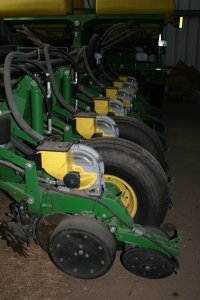Producers gear up for planting season with proper equipment
You carefully plan your crop rotations, shop for seed varieties, budget wisely for chemicals and analyze the markets. But nothing is more important than getting your no-till crop off to the right start with proper seeding.
 Attaining good stands in no-till requires hard working planters and drills that can handle residue without the hassle of plugging, penetrate the soil to the desired seeding depth, establish proper seed-to-soil contact and effectively close the seed-vee.
Attaining good stands in no-till requires hard working planters and drills that can handle residue without the hassle of plugging, penetrate the soil to the desired seeding depth, establish proper seed-to-soil contact and effectively close the seed-vee.“Having the right equipment, functioning properly is one of the most important factors in no-till,” says Sterling, KS no-till farmer, Lee Scheufler. “It may seem expensive or tedious—but it’s time and money well invested.”
Scheufler and his wife, Margaret, began no-till farming in 1996 after seeing success with on-farm trials. “We decided to gradually switch from conventional tillage to no-till over several years, but in terms of equipment and mindset it was difficult to do both. By 2002 we were 100% no-till with a capital ‘N’ we do as little to disturb the soil as possible.”
The Scheufler’s do that by keeping it simple, yet being open minded. “As far as equipment—we don’t do anything exotic, it doesn’t have to be fancy to get the job done. We have always been the type to test things for ourselves before completely adopting it.”
Keeping with the idea of “try before you buy” the Scheufler’s also do custom work, making it possible for other producers in the area to try no-till without long term commitment. “It’s really about finding what works best for you,” Scheufler said. “It’s not about what everyone else is doing, or having the biggest or best —but about what fits your farm and operation.”
By evaluating the strengths and weaknesses of any piece of planting equipment and making few (if any) adjustments— many available planters and drills can be no-till worthy,, said University of Nebraska-Lincoln Extension Engineer, Paul Jasa.
With appropriate weight, down pressure and adjustments, most current planters and drills will perform well in no-till conditions, Jasa said. A little time spent in the early spring will help avoid headaches and delays later during the planting season, so consider your equipment needs now.
“Planters and drills are built with large diameter, disk seed furrow openers, making no-till easy,” Jasa said. “Check the double-disk seed-furrow openers on the planter, before the planting season, for wear and proper adjustment. The individual disks can be adjusted inward as they wear by removing spacer washers from behind them. This keeps the two blades of the seed-furrow opener working together as one cutting edge, making a coulter unnecessary.”
Jasa adds that if the two blades are mounted side-by-side, they should have about two inches of blade contact on the leading edge. On staggered disk seed-furrow openers, the rear disk should be tucked in behind the leading disk, just touching.
“Adjust the disks or replace them to maintain the proper configuration. When properly adjusted, these seed-furrow openers can easily cut residue and penetrate the soil without coulters or row cleaners,” Jasa said.
 The seed must be placed in moist soil, at a depth suitable for proper rooting and growth (2 to 3 inches for corn). With no-till, the depth control is usually set deeper than normal because the depth gauge wheels are riding on a layer of residue. “To ensure penetration to desired seeding depth, down pressure springs may be needed to transfer weight from the planter toolbar to the individual row units,” Jasa said.
The seed must be placed in moist soil, at a depth suitable for proper rooting and growth (2 to 3 inches for corn). With no-till, the depth control is usually set deeper than normal because the depth gauge wheels are riding on a layer of residue. “To ensure penetration to desired seeding depth, down pressure springs may be needed to transfer weight from the planter toolbar to the individual row units,” Jasa said.“There must be sufficient weight on the units to keep the depth gauge wheels in firm contact with the ground to control planting depth. If the gauge wheels are loose, tighten the down pressure springs or add heavy-duty springs. There also needs to be enough total weight on the toolbar to keep the planter drive wheels in firm contact with the ground to prevent slipping and to help keep the planter on the row.”
Having enough weight becomes even more of a problem with drills, simply because of the number of rows per unit width. Air seeders often use the downward suction of the chisel points to aid in penetration. However, weight may still have to be added, especially on those that use the large diameter, single disk openers and on those that use an air cart to carry the weight of the seed and seeding mechanism, Jasa said. Using a 10-, 12-, or 15-inch row spacing decreases the amount of weight required and reduces equipment costs.
Jasa also notes that sufficient weight must remain on the press wheels to ensure firming of the seed into the soil. “Wet soil is easily compacted and care must be taken not to over pack the soil, making it difficult for seedlings to emerge or for the seedling roots to penetrate the soil,” he said. “Likewise, too much weight on the depth gauge wheels may cause sidewall compaction in wet soils. In dry soil conditions, extra down pressure and closing force may be needed. The key is to evaluate seed-to-soil contact, not the top of the seed-vee, when setting the down pressure on the press wheels. As long as the contact is there, the down pressure should not be increased.”
Jasa said that something as simple as a harrow that acts to close the top of the vee and pull light residue cover back over the vee may be all that is needed -- a common practice on drills that use a narrow press wheel in the bottom of the seed-vee to get seed-to-soil contact.
If extra help is needed to close the seed-vee, spiked, curved tine, or lugged closing wheels can be used to “till” the seed furrow closed and reduce sidewall compaction, Jasa said. The down pressure on the closing wheels has to be reduced so as not to till the seed out of the seed furrow.
Before the busy planting season, take the time to check on how well your no-till planting equipment will perform. By checking early on you will have more time to make adjustments, fix any problems and avoid the pains of future problems.



No comments:
Post a Comment